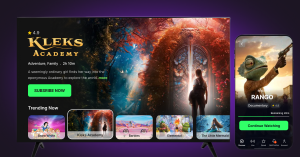Not everyone in your community can walk into the church on a Sunday; some may be traveling, while some may be bedridden. These people deserve to attend Sunday congregations; that’s why live streaming church services matters, as it helps eliminate physical barriers.
Moreover, live streaming is a blessing in disguise for churches, because they were losing their faith-based community. Now, churches can connect with their community directly through live streaming.
If you’re a church admin reading this, remember: you cannot deploy a plug-and-play approach to live stream church services.
In this blog, we’ll walk you through the essentials of live streaming setup, the benefits of online church services, and 5 major platforms to live stream. Let’s get started.
Why Live Stream a Church Service?
What used to be a spiritual practice has turned into a fading habit. A survey from Gallup indicates that the majority of Americans say they seldom (25%) or never (33%) attend church meetings. On the contrary, 2 in 3 (67%) Americans say they attended religious meetings weekly when they were growing up.
This contrasting shift highlights changing lifestyles, barriers to attendance, and evolving expectations. As a church admin or a pastor, you cannot solve every pain point that prevents worshippers’ attendance. However, live streaming offers a powerful solution to earn the faith of your community, and also to instill faith in them!
Benefits of Live Streaming Church Services
We have covered the fundamental reasons for live streaming church services; now it’s time to explore the meaningful benefits that your ministry can reap.
Here are those benefits:
- Increased Accessibility
Let’s say grandparents live in the remotest part of North Carolina and grandchildren in the Charlotte Metropolitan area, the church live streaming brings them together while creating a spiritual bonding across generations.
Live streaming presents a viable alternative for in-person worship; however, mind you, it cannot replace the spirituality of the in-person congregation.
- Wider Reach
Of course, live streaming takes your church online services across multiple nations. Your church can go from a local congregation to a global congregation within just a few minutes.
Multi-streaming can help you reach diverse audiences on multiple platforms like YouTube, X (formerly Twitter), Facebook, and Instagram. Employing a church live streaming platform with built-in simulcasting functionality lets you broadcast your sermon to audiences across social platforms.
- Monetization
Online church services can bolster your church operations with additional revenue streams: donations, virtual access, and exclusive prayers for paying members.
While expanding physical facilities can cost you a fortune, expanding your ministry and reaching more people is possible through live streaming at a sustainable cost. This promises growth while not spending much.
How to Live Stream Online Church Services?
We hope that you understand the significance of live streaming in bringing communities together. Setting up church live streaming can be enormous at once, but breaking it down into manageable steps might help you. Here’s your roadmap:
1. Choose a Platform
The live streaming platform you choose for online church services is the cornerstone of your streaming setup. The choice will determine how your church community feels towards online church services.
Some platforms simplify interaction, while some emphasize accessibility, empowering laypersons to join church live streaming. The ultimate goal is to find a platform that best fits your congregation’s needs.
If you have second thoughts about the best platform, we have some recommendations for you later in this blog (Bonus!).
2. Determine Your Equipment Needs
The equipment you choose lays the foundation for your vision of taking your church global. You needn’t always choose the expensive one, but take your church’s needs and budget into consideration.
Consider the size of your church, because it is a decisive factor in your equipment search. Also, you should consider the number of people involved in your church service as it’ll directly impact the viewer experience.
Taking these factors into consideration during the church live streaming setup will avoid overspending on unnecessary tools.
3. Set Up Your Internet Connection
A stable internet connection is the backbone of any successful church live streaming. Even the best of cameras and live streaming platforms struggle with an unstable internet connection. Aim for:
- Upload speed: 5 Mbps for standard quality, 10 Mbps or higher for HD streaming.
- Use a wired Ethernet connection, if possible. Avoid using Wi-Fi as much as you can.
- If you are left with Wi-Fi only, keep the router close to your streaming setup.
4. Plan Your Streaming Schedule
Just like people know to turn up for a Sunday morning session, remote worshippers should know their schedule.
Plan your church streaming schedule in advance, let the community know about the schedule: you can use church websites, social media pages, or Email newsletters.
It is advisable to consider the needs of your community. For example, if most office-goers prefer a mid-week evening service at 7pm (as opposed to 6pm), you can consider that. This will ease the participation and increase the attendance.
5. Test Your Setup
Never stream a live church session before testing your equipment first. A quick ‘Trial’ test can save your church live stream setup from issues like unstable internet, microphone issues, and poor lighting.
It is a good idea to run a test stream in your church live streaming platform on multiple devices (mobile phones, TVs, laptops). This will help you figure out how well the audio and video blend across devices.
Tools and Equipment Needed for Online Church Services
You have witnessed how planning, scheduling, and testing can optimize the church’s live stream session. But even the best of the plans will struggle with poor equipment. Let’s explore the best tools and equipment that make your church live streaming impactful:
Disclaimer: All equipment recommendations are for reference purposes only. Please conduct your own research and consider your specific budget and requirements before making any purchases.
1. Camera
A good-quality camera gives that sense of belonging to the remote worshippers even if they are far apart from the church.
Our recommendations:
- Webcam: Logitech Brio 4K
- DSLR: Canon EOS Rebel T8i (EOS 850D)
- Camcorder: Canon XA50
- PTZ Camera: Canon CR-N300
- Action camera: GoPro HERO12 Black
2. Microphone
Transmitting the exact environment of the church during live streaming can be a challenge, but that’s where the significance of a good microphone lies. You need a microphone that carries and conveys the message of the pastor, as it is.
Here are our recommendations:
- Lavalier Mic (Clip-on): Rode Lavalier GO
- Handheld Mic: Shure SM58
3. Video Encoder
Church live streaming is indispensable without an encoder, which is a software/hardware that converts audio and video into a transmittable file over the internet. It breaks the large data into manageable chunks to optimize the live streaming experience.
While software encoders offer a great deal of freedom to tweak the video quality, the hardware encoders don’t offer that freedom. Choose wisely!
4. Tripod
Tripod is mandatory for a stable and sturdy live streaming session. You have to choose a flexible and durable tripod that caters to any worship environment.
Our recommendations:
- Manfrotto 290 Xtra Aluminum Tripod with Fluid Head
- UBeesize 67” Camera Tripod (Budget-friendly)
5. Lighting
Regardless of the equipment you choose for the church live stream setup, your video quality depends on the lighting.
You can follow the common standard three-point lighting mechanism to enhance the lighting in your church live streams.
And remember to check the lighting at regular intervals to avoid unprecedented shadows, thereby maintaining a clear visual for your virtual congregation.
The Top 5 Live Streaming Platforms for Online Church Services
With the streaming setup knowledge in hand, it becomes imperative to choose an ideal live streaming platform that takes your church’s message global. Here are the top 5 platforms for remote church services:
1. VPlayed
VPlayed is a church live streaming platform built to deliver a seamless, high-quality worship experience to your global congregation. The platform lets you simulcast church services (like prayers and sermons) across multiple platforms, helping you reach worshippers worldwide in real time.
And if you’re worried about those who missed the live stream, this platform lets you convert live streams into video on-demand (VOD), which you can share as recordings to those who missed the event.
VPlayed allows you to scale up your streaming experience with as many as 200+ third-party integrations—empowering your ministry with tools for audience engagement, analytics, monetization, and seamless content delivery across platforms.
Why does VPlayed stand out?
* 100% Customization Freedom
* Third-Party Analytics Integration
* Built-in HLS Video Player
* 10+ Monetization Models
* Adaptive Bitrate Streaming (ABR)
* Global Built-in CDN
* Organized Video CMS
* Multi-Language Support
So, that’s VPlayed in a nutshell. Now, let’s see who’s stepping up next.
2. GUDSHO
GudSho is a live streaming platform that brings faith-based communities together with reliable features. It helps local churches to host, manage, and stream sermons or any church services worldwide without any hassles.
It lets you broadcast your sermons across social channels directly, enabling your church to reach a wider audience.
GudSho bolsters your effort to build a strong online presence for your church while making a long-lasting impact on your community.
Why does GudSho stand out?
* 5+ Monetization Models
* Scheduling options
* Low-latency streaming
* Analytical dashboard
* Live streaming to VOD conversion.
So, that’s all about GudSho. Let us see who’s next up the list.
3. OnTheFly
OnTheFly is a dedicated multi-streaming platform that lets you broadcast your church services to 100+ social platforms simultaneously. The platform drives 3x the engagement for your online congregation with real-time chat and visual elements.
With a user-friendly interface, OnTheFly lets you offer an impeccable streaming experience to the remote worshippers.
Why does OnTheFly stand out?
* Multi-streaming with RTMP server
* Branding Freedom
* Live stream recording
* Real-time Chat
* Analytical dashboard
So, that’s all about OnTheFly. Let us see who’s next up on the list.
4. Vimeo
Vimeo is a video live streaming platform that allows churches to live stream and host pre-recorded content. The basic functionalities of Vimeo include analytics, simulcasting, engagement tools (like polls, Q&As), privacy controls, and other exciting features.
With Vimeo, you get to know the real-time feedback of your church live streaming session. You can monitor the status of your live stream, and address the issues in real-time.
Why does Vimeo stand out?
* Live Chat, Polls, Q&As
* Health Monitoring
* Scheduling options
* Analytics Dashboard
* Guest Invite URLs
So, that’s all about Vimeo. Let us see who’s up next.
5. Dacast
Dacast is a live streaming platform that allows churches to broadcast live sermons or prayers worldwide. This platform uses HLS (HTTP Live Streaming) protocol to broadcast live streams across multiple devices and platforms.
Dacast also supports low-latency streaming so that your church services can reach remote worshippers without any lag.
Why does Dacast stand out?
* Advanced Analytics
* Monetization options
* Easy-to-use Interface
* HTML5 Video Player
* Social Media Integration.
It’s A Closure
We have reached the end of the blog. We have outlined essential details on how to live stream church services, including the necessary tools & equipment, as well as our top 5 platform recommendations.
From premium platforms like Vimeo and Dacast to flexible yet scalable platforms like VPlayed and GudSho, you can choose your ideal live streaming platform that fits your church’s needs.
Take your time to compare, analyze, and consider your options by exploring platform demos until you find your go-to platform. And if you want to try any platform, you can request VPlayed for a demo today.



